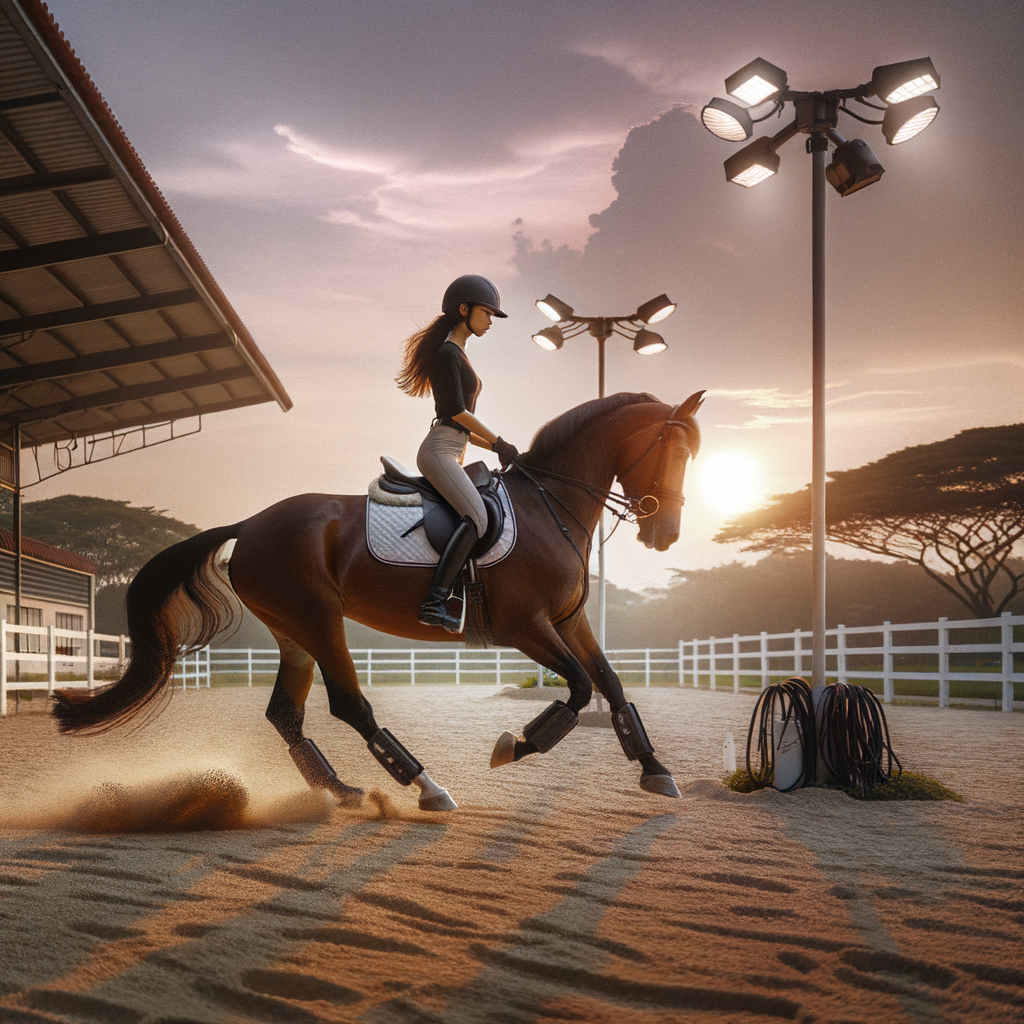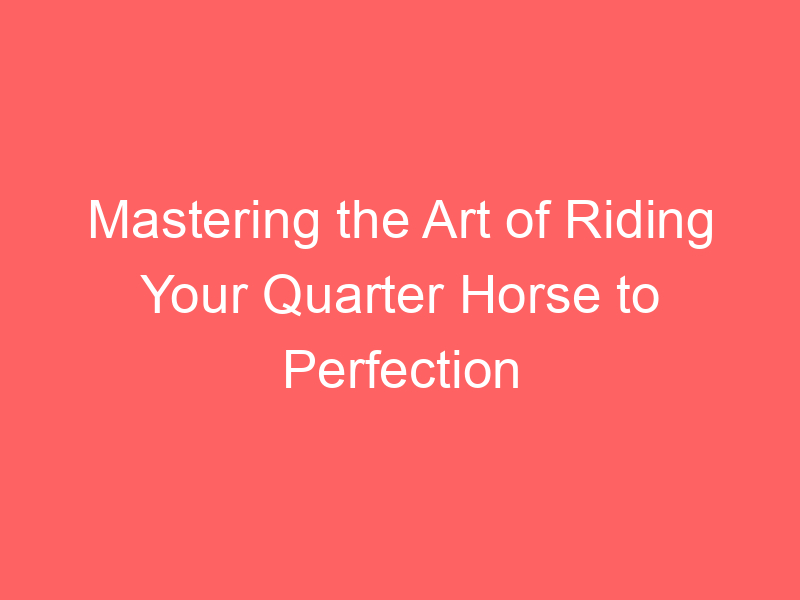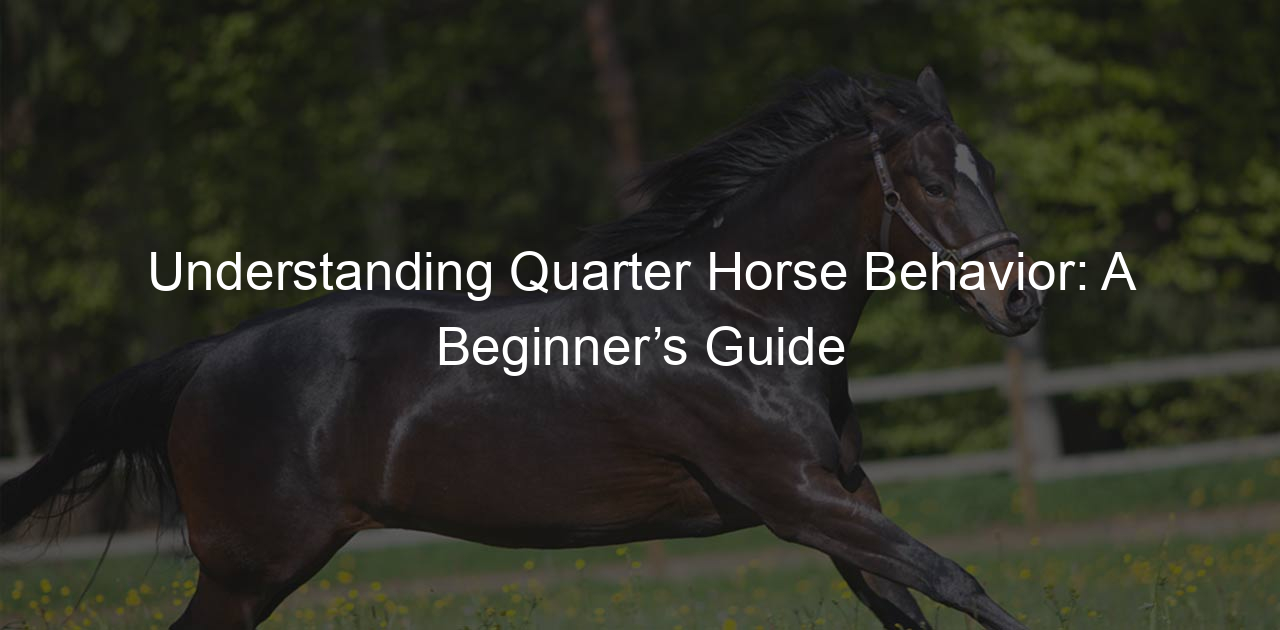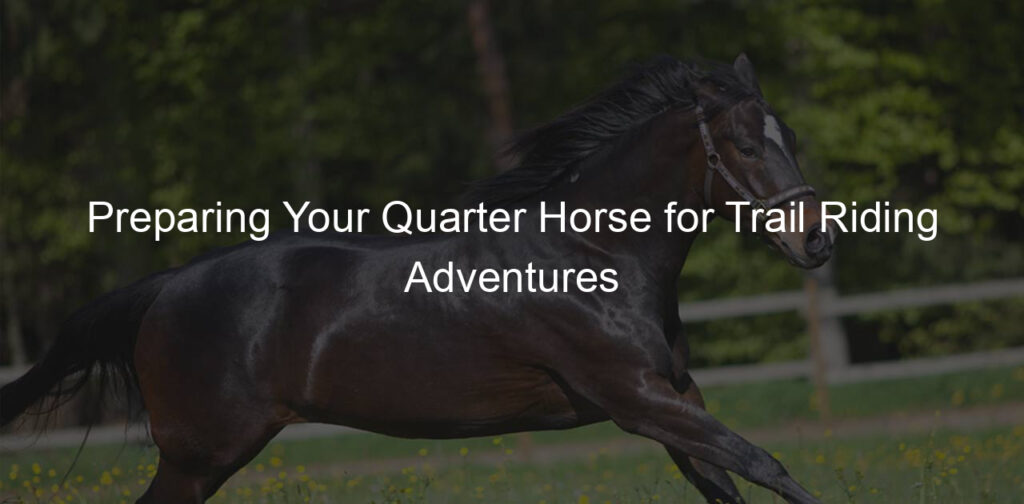
Introduction to Quarter Horse Training
Quarter Horse Training is a fascinating and rewarding journey that requires patience, dedication, and a deep understanding of the horse’s nature. This introductory guide will help you understand the basics of Quarter Horse Training and the importance of mastering horse riding techniques.
- Understanding the basics of Quarter Horse Training
- Importance of mastering Horse Riding Techniques
Quarter Horse Training is a specialized field that focuses on the training of the American Quarter Horse, a breed known for its speed and agility. The basics of Quarter Horse Training involve understanding the horse’s behavior, learning how to communicate with the horse, and teaching the horse to respond to commands. It’s important to remember that every horse is unique, and what works for one may not work for another. Therefore, patience and adaptability are key in this process.
Mastering horse riding techniques is crucial for successful Quarter Horse Training. Good riding skills not only ensure the rider’s safety but also contribute to the horse’s comfort and well-being. By learning how to sit, steer, and control the horse properly, you can create a harmonious relationship with your horse and improve its performance. Remember, the goal is not to control the horse, but to work together as a team.
In conclusion, Quarter Horse Training is a rewarding journey that requires a deep understanding of the horse and mastery of riding techniques. Whether you’re a beginner or an experienced rider, there’s always something new to learn in this exciting field.
Improving Horse Riding Skills
Improving your horse riding skills is a journey that requires patience, practice, and a deep understanding of your horse. This section will provide you with essential techniques to help you improve your skills and become a more proficient rider.
Essential Horse Riding Techniques
There are two fundamental techniques that every rider should master:
- Mastering the Basic Riding Posture
- Understanding the Horse’s Movements and Reactions
Having the correct riding posture is the foundation of good horse riding. It ensures you maintain balance and control, and it also helps you communicate effectively with your horse. The basic riding posture involves sitting up straight with your shoulders back, keeping your heels down, and your knees and toes pointing forward. Your hands should be low and close to the horse, and your eyes should always be looking ahead.
Understanding your horse’s movements and reactions is crucial in horse riding. Horses communicate through their body language, and being able to interpret these signals can greatly improve your riding skills. For instance, if a horse’s ears are pinned back, it could indicate that the horse is irritated or frightened. On the other hand, a relaxed tail and soft eyes usually mean the horse is calm and comfortable. By understanding these signals, you can respond appropriately and build a stronger bond with your horse.
Mastering these essential techniques will not only improve your horse riding skills but also enhance your overall riding experience. Remember, practice makes perfect, so don’t be discouraged if you don’t get it right the first time. Keep practicing, and you’ll see improvement over time.
Advanced Horse Riding Techniques
As we continue our journey to improve our horse riding skills, we will now delve into some advanced techniques. These techniques will help you take your riding skills to the next level. They require a bit more practice and understanding of your horse’s movements, but the results are truly rewarding. Let’s explore these techniques in detail.
- Perfecting the Gallop
- Always start with a slow and controlled canter before transitioning into a gallop.
- Keep your body relaxed and move with the horse’s motions.
- Hold the reins firmly but don’t pull back unless you want to slow down.
- Practice on a flat, open space before trying out on different terrains.
- Mastering the Jump
- Start with small jumps and gradually increase the height as you and your horse become more confident.
- Approach the jump at a steady pace. Too slow, and your horse might refuse the jump. Too fast, and your horse might knock the obstacle over.
- Look ahead and not at the obstacle. Your horse will follow your gaze.
- Use your legs to give your horse the signal to jump, not the reins.
The gallop is the fastest gait of a horse, with all four feet leaving the ground during certain phases of its stride. This is where the thrill of horse riding truly lies. However, it requires a good understanding of balance and rhythm. Here are some tips to perfect the gallop:
Remember, practice makes perfect. So, don’t be discouraged if you don’t get it right the first time.
Jumping is not just about getting your horse to leap over obstacles. It’s about precision, timing, and trust between you and your horse. Here’s how you can master the jump:
Jumping can be a bit scary at first, but with practice, it becomes a thrilling part of horse riding.
These advanced techniques will not only improve your horse riding skills but also strengthen the bond between you and your horse. Remember, every rider was once a beginner, and every professional was once an amateur. So, keep practicing and enjoy the journey of mastering horse riding.
Quarter Horse Riding Tips
Mastering the art of riding a Quarter Horse can be a rewarding experience. Here are some tips to enhance your journey.
Enhancing Your Quarter Horse Experience
Two key factors can significantly improve your Quarter Horse riding experience: building a strong bond with your horse and understanding its unique personality.
- Building a strong bond with your Quarter Horse
- Understanding your horse’s unique personality
Building a strong bond with your Quarter Horse is the first step towards a rewarding riding experience. Spend quality time with your horse, grooming, feeding, and walking it. This will not only help you understand your horse better but also build trust and mutual respect.
Just like humans, horses have unique personalities. Some are shy and reserved, while others are outgoing and energetic. Understanding your horse’s personality can help you adapt your riding style to suit its temperament. This will make your riding experience more enjoyable and less stressful for both you and your horse.
Remember, patience and consistency are key when it comes to horse riding. With time and practice, you’ll be able to master these skills and enhance your Quarter Horse riding experience.
Training Quarter Horses: Do’s and Don’ts
Training a Quarter Horse can be a rewarding experience. However, it’s crucial to know the right techniques and avoid common mistakes to ensure a successful training journey. Let’s delve into the do’s and don’ts of Quarter Horse training.
- Effective Training Techniques
- Consistent Routine: Horses thrive on routine. Establish a consistent training schedule to help your horse understand what to expect.
- Positive Reinforcement: Reward your horse for good behavior. This could be a treat, a pat, or verbal praise. This encourages them to repeat the behavior.
- Understanding Horse Behavior: Learn to read your horse’s body language. This will help you understand their needs and respond appropriately.
- Common Mistakes to Avoid
- Rushing the Training Process: Every horse learns at their own pace. Don’t rush the training process. Give your horse the time they need to learn and understand new concepts.
- Neglecting Horse Care: Good training goes hand in hand with proper horse care. Ensure your horse is well-fed, groomed, and has regular vet check-ups.
- Ignoring Signs of Stress: If your horse is showing signs of stress or discomfort, don’t ignore them. It could be a sign that something is wrong.
Training a Quarter Horse requires patience, consistency, and understanding. Here are some effective techniques:
While training your Quarter Horse, there are some common pitfalls you should avoid:
Remember, training a Quarter Horse is a journey, not a destination. With patience, understanding, and the right techniques, you can help your horse reach their full potential.
Perfecting Horse Riding Skills
Mastering the art of horse riding is a journey that requires dedication, practice, and the right techniques. In this section, we’ll focus on practical exercises that can help you perfect your horse riding skills.
Practical Exercises for Improvement
Practical exercises are an essential part of improving your horse riding skills. They help you gain better control over your horse and improve your balance and coordination. Let’s take a closer look at these exercises.
- Riding Drills for Better Control
- Exercises for Improving Balance and Coordination
Riding drills are designed to improve your control over the horse. They involve various maneuvers such as turning, stopping, and changing gaits. One popular drill is the ‘serpentine drill’, where you guide your horse in a series of S-shaped curves. This drill not only improves your control but also enhances your horse’s flexibility and responsiveness.
Balance and coordination are crucial for a smooth and safe horse riding experience. A simple but effective exercise is the ‘no stirrups’ drill. In this exercise, you ride your horse without using the stirrups, which forces you to balance using your core muscles. This exercise can significantly improve your balance and coordination over time.
Remember, practice makes perfect. Regularly practicing these exercises can help you become a more skilled and confident horse rider. In the next section, we’ll explore ways to enhance your horse riding experience.
Enhancing Your Horse Riding Experience
When it comes to perfecting your horse riding skills, there are a few key areas that can truly enhance your experience. Let’s explore them.
- Exploring different riding terrains
One of the most exciting aspects of horse riding is the opportunity to explore different terrains. Each terrain presents its unique challenges and rewards, making every ride a new adventure. Riding on flat, even ground is a great starting point for beginners. As you gain confidence and improve your skills, you can gradually move on to more challenging terrains like hills, forests, and even beaches.
Did you know that riding on different terrains can also benefit your horse? According to a study, horses that are ridden on varied terrains have better foot health and stronger muscles compared to those ridden only in arenas. So, not only does exploring different terrains make your rides more interesting, but it also contributes to your horse’s overall health and well-being.
- Participating in horse riding events and competitions
Another way to enhance your horse riding experience is by participating in events and competitions. These events provide a platform for riders to showcase their skills, learn from others, and receive constructive feedback. Whether it’s a local horse show, a national competition, or a fun charity ride, participating in these events can be a rewarding experience.
Competitions also provide an opportunity to set goals and work towards them. This process of setting and achieving goals can significantly improve your riding skills. Plus, the thrill of competition and the joy of achievement can make your horse riding experience even more enjoyable.
In conclusion, exploring different terrains and participating in horse riding events and competitions are two effective ways to enhance your horse riding experience. So, why not give them a try? You might be surprised at how much they can improve your skills and enrich your horse riding journey.
Quarter Horse Riding Improvement: Case Studies
Let’s delve into some real-life examples of how individuals have improved their Quarter Horse riding skills. These case studies will provide valuable insights and lessons learned from common training mistakes.
- Success stories of improved horse riding skills
- Lessons learned from common training mistakes
Meet Jane, a 12-year-old horse riding enthusiast. She started riding Quarter Horses at the tender age of 8. Initially, she struggled with maintaining balance and controlling the horse’s speed. However, with consistent practice and a focused training regimen, she has now become a proficient rider. She has won several local horse riding competitions and is now preparing for her first national competition.
Another success story is that of John, a 35-year-old who had never ridden a horse before. He decided to take up horse riding as a hobby. Despite facing numerous challenges, John did not give up. He took lessons from a professional trainer and spent countless hours practicing. His determination and hard work paid off when he successfully completed a 20-mile trail ride on a Quarter Horse.
One common mistake that many novice riders make is not investing enough time in understanding the horse’s behavior. For instance, Tom, a beginner rider, initially struggled with controlling his horse because he did not understand the horse’s signals. After attending a few workshops on horse behavior, Tom was able to better communicate with his horse, leading to a significant improvement in his riding skills.
Another common mistake is neglecting the importance of proper riding gear. Emily, an amateur rider, learned this the hard way when she fell off her horse due to wearing inappropriate footwear. After this incident, Emily invested in proper riding boots and saw a noticeable improvement in her balance and control while riding.
These case studies highlight the importance of perseverance, understanding horse behavior, and using appropriate riding gear. Remember, improving your horse riding skills is a journey, not a destination. Keep learning and practicing, and you will see progress over time.
Conclusion: The Joy of Mastering Quarter Horse Riding
As we reach the end of our exploration into Quarter Horse riding, it’s time to reflect on the journey. From the basics of horse training to the fine-tuning of riding skills, we’ve covered a lot of ground. But the true joy of this sport lies not just in the knowledge and skills acquired, but in the lifelong journey and fulfillment that comes with mastering Quarter Horse riding.
- The fulfillment of perfecting horse riding skills
- The lifelong journey of Quarter Horse riding
There’s a unique sense of fulfillment that comes from perfecting horse riding skills. It’s not just about being able to control a horse or execute complex maneuvers. It’s about the bond you form with your Quarter Horse, the understanding you develop of its unique personality and quirks, and the confidence you gain in your own abilities.
Remember the case studies we discussed earlier? Each rider started from a different point, but they all experienced a similar sense of fulfillment when they mastered a new skill or overcame a challenging obstacle. That’s the beauty of Quarter Horse riding – it’s a journey of continuous learning and growth, and every step forward brings its own rewards.
Quarter Horse riding isn’t a skill you learn once and then forget. It’s a lifelong journey, filled with ups and downs, triumphs and challenges. But through it all, the joy of riding, the bond with your horse, and the thrill of mastering new skills keep you going.
As you continue your journey in Quarter Horse riding, remember the tips and techniques we’ve discussed in this blog. They’re not just guidelines for improving your skills, but stepping stones on your path to mastering this wonderful sport. And as you progress, don’t forget to celebrate your achievements – because every step forward is a testament to your dedication, hard work, and love for Quarter Horse riding.
In conclusion, the joy of mastering Quarter Horse riding lies in the journey itself – in the challenges overcome, the skills learned, and the bond formed with your horse. It’s a journey of continuous learning and growth, and every step forward brings its own rewards. So saddle up, hold the reins tight, and embark on your own journey of mastering Quarter Horse riding. The road may be long, but the rewards are well worth the ride.









